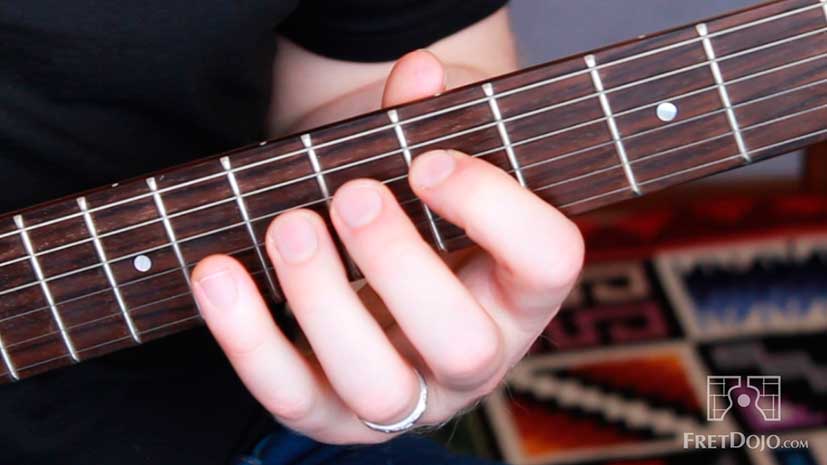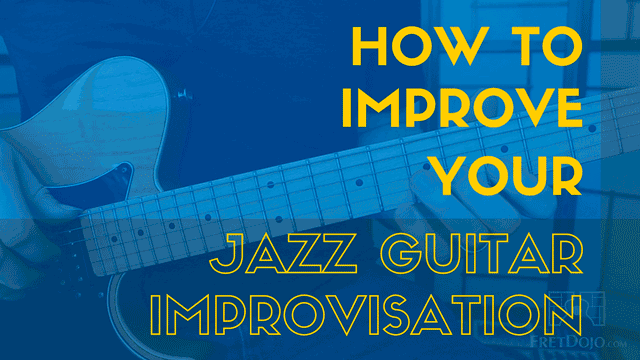Yeah baby – in today’s beginner jazz guitar lesson you’ll learn a very cool bossa nova chords progression – and I’m going to show you how to build up one of the most useful bossa nova guitar rhythm patterns step by step.
If you can play one bossa nova rhythm well you can play them all I think, so today I’m going to show you one of the most useful bossa nova guitar patterns that I tend to use when playing Brazilian guitar chords at gigs.
Stick around to the end of this bossa nova guitar lesson because as a bonus I’m also going to give you some very useful jazz chord voicing tweaks to help make your playing instantly sound more authentic with those cool Brazilian guitar chords.
Bonus PDF Download: To get your free printable PDF which has the bossa nova guitar tab for this lesson, go here>>
Video Sections:
00:00 Introduction
01:31 Exercise 1 – Basic Bossa Nova Guitar Pattern
02:06 Fingerstyle Warmups For Bossanova Guitar Chords
05:34 Exercise 1a – Alternating Bass on Bossa Nova Guitar Chords
07:07 Exercise 2 – Adding Syncopation
10:02 Exercise 2a – Syncopation + Alternating Bass
11:29 Exercise 3 – Chords Anticipation in Bossa Nova Chord Progressions
16:22 How Insensitive Bossa Nova Comping Example
17:22 Next Steps
Let’s go through everything I cover in the video step by step:
Step 1 – Basic Pattern For Bossa Nova Chord Progression
(see video at 01:31)

Let’s build this up little by little. Start with a basic Dmaj7 chord and only hold that one for this exercise.
So pretty easy in the left-hand, but on the plucking hand, we’ve got a bit of fingerstyle work to do. Fingerstyle is the preferred plucking technique for bossa nova comping as it’s very natural to play these kinds of rhythm patterns like this.
Notice how the thumb plays on beats 1 and 3 of the pattern. This is typical with bossanova guitar chords – the bass remains steady on these beats while the fingers create interesting counter rhythms over the top.
Use the thumb for the bass notes and your index, middle and ring fingers for the top notes. As a warmup exercise, alterate playing a bass note with the thumb with the top three open strings with your fingers to get a grip on the movements.
This can take a bit of time to get used to, so don’t worry if you can’t do that straight away – practice make progress!
Step 1a – Alternating Bass on Bossa Nova Guitar Chords
(see video at 05:34)

This one is very similar to the first one above. The only difference is how you alternate the bass between the 5th and 6th strings, creating more interest.
Step 2 – Adding Syncopation (see video at 07:07)

Awesome – we’re nearly to the point where you’re going to be able to play the full bossa nova guitar pattern I’m leading you to.
This one provides a bit more syncopation to the rhythms you are playing with the fingers.
It’s good to stick to a steady groove with bossa nova guitar, but sometimes it’s nice to mix up things a little bit and put a little bit more syncopation in those upper notes.
Yes, it does look complicated on the sheet music, but when you listen to it and play along with the video, your ears will make sense of how the rhythm should go.
Step 2a – Syncopation + Alternating Bass (see video at 10:02)

We are getting sooooo close to our ultimate bossa nova chords progression pattern, but just one more step before we get there.
You’re going to do the same thing that we just did in the previous exercise, but all we need to do now is alternate the bass note back and forth between the 5th and 6th strings.
Step 3 – Chords Anticipation in Bossa Nova Chord Progressions
(see video at 11:29)

Here it is – the final pattern!
This is actually very similar to the pattern that you did in the previous example. This time, you’re adding a little upbeat anticipation on some of the chords.
Instead of just a single chord in the fretting hand, you now have:
Dmaj7 | Bbdim7 | Am7 | D7(b9) | Gmaj7
Notice on the upbeat to the Bbdim7 and the D7(b9) I anticipate the chord by an eighth note.
If you want to sound really hip with this Brazilian style, grab the chord voicing on the upbeat to the next bar here and there when you play bossa nova chord progressions.
Also, as I demonstrate on the video, have a go at moving the top note in the voicings up and down as you play the pattern to make a quasi-melody – this can make the comping sound very sophisticated.
Wrap Up & Next Steps:
Bonus PDF Download: To get your free printable PDF which has the bossa nova guitar tab for this lesson, go here>>
I hope this post got you inspired to give this bossa nova chords progression pattern a try.
Bossa nova guitar is one of the coolest comping techniques and is essential knowledge for any jazz guitarist – many jazz standards are in a Latin feel and so at some point you’ll definitely to be asked to play with this kind of rhythm pattern.
Over to you – leave a comment to let me know what YOUR favorite bossa nova tunes are so I know which bossa nova chord progressions I should focus on in future lessons on this website.
~ Greg O’Rourke
BMus (Hons), ANU
Founder, FretDojo.com
World Leader in Online Jazz Guitar Lessons


Girl from Ipenema, thanks for the lesson Greg
Favourite Bossa: Wave or Corcovado
I’m with Eric: Wave by Jobim!
One of my favourite bossa nova tunes is One Note Samba. It is an extraordinary feat of composition, using a plethora of chords, almost all of which share a common note, and then it launches into a gorgeous quickfire melody featuring one word per note runs that are simply to die for.
It’s built around tri- tone subs which Greg covered some time ago I think. Excellent piece for practicing tri tone sub in many different voicings. Favorite: Laurendo Almeida and the Modern jazz quartet
Corcovado..thank u so much for your generosity
Brilliant lesson… congratulations – Very good pace and good visual aids too. I would really love a lesson on Wave or Chega de Saudade! Regards from Dublin :)
Girl from Ipanema of course but Nature Boy is also great done in Bossa style
I think my favorite is Outra Vez. Thanks for the lesson.
A wonderful lesson. I like the way you slowly built up the progression to Ex. 3. Like you, I started out as a classical player of transcriptions of Bach et. al, but have moved to jazz . Bossa Nova was my gateway to jazz and it has always had a great pull for me since I play with my fingers only. The first Bossa Nova tune that I learned was Manha de Carnaval (Black Orpheus) with its simple diatonic chord changes. Like some of the others who have left their comments, I would like to see you develop a lesson on Corcovado as well as one of my favorites, Meditation. Each have beautiful melodies with 2-5-1 changes plus the use of other chords diatonic to C major as well as secondary dominants.
Corcovado is by far my favorite.
Greg, That was beyond WAY COOL ! Stan Getz/ The Shadow of Your Smile or Sergio Mendez/ Night and Day. Thank you very much.
i like this tutorial thanks
Hi Greg… always loved Bossa Nova music. Girl From Ipanema, One Note Samba, etc. Pretty much anything by Antonio Carlos Jobim.
Enjoyed the lesson very much.
nice and intresting
Slowly by Julianna Raye….or any bossa nova by Julianna Raye. Her voice is fantastic.
Hi Greg,
Thankyou for the lesson, particularly your teaching in slow steps. My choice would have to be Girl from Ipenema,
Thanks again,
Greg
Glad you enjoyed the lesson Greg. Yes Greg is a wonderful teacher as well as a fantastic player. Not a common combo!
Meditation
Thanks for the lesson. Desifinado, Wave.